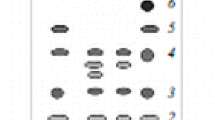Summary
A new sensitive spot test for aliphatic, aromatic and heterocyclic aldehydes is introduced. Limits of identification for over 70 aldehydes are recorded. All tested aldehydes except chloral and hexadecanal give positive tests revealed by a blue or a green color with an absorption maximum around 610 to 630 nm (mμ). For the determination of total aldehyde, the procedure is at best an estimation.
Zusammenfassung
Eine neue Tüpfelprobe für aliphatische, aromatische und heterocyklische Aldehyde wird vorgeschlagen. Die Erfassungsgrenzen für mehr als 70 Aldehyde werden angegeben. Mit Ausnahme von Chloral und Hexadekanal geben alle geprüften Aldehyde eine blaue bis grüne Färbung mit einem Maximum der Absorption bei 610 bis 630 nm. Eine kolorimetrische Bestimmung des Gesamtaldehyds kann nur mit einer relativen Präzision von etwa ±0,1 ausgeführt werden.
Résumé
Introduction d'un nouvel essai à la touche sensible pour les aldehydes aliphatiques, aromatiques et hétérocycliques. Les auteurs donnent les limites d'identification pour plus de 70 aldehydes. Tous les aldehydes essayés donnent des essais positifs à l'exception du chloral et de l'hexadecanal; cet essai se traduit par l'apparition d'une couleur bleue ou verte ayant un maximum d'absorption au voisinage de 610 à 630 nm. Pour la détermination de l'aldéhyde total la technique peut être considérée au mieux comme une estimation.
Similar content being viewed by others
Literature
H. Schiff, Ann. Chem.140, 93 (1866).
F. Feigl, Spot Tests in Organic Analysis, 5th ed. New York: Elsevier. 1956. p. 208.
R. Wasicky andO. Frehden, Mikrochim. Acta [Wien]1, 55 (1937).
G. S. Buchanan andS. B. Schryver, Analyst34, 470 (1909). 5 Ref. 2, p. 213.
L. P. Kuhn andL. De Angelis, J. Amer. Chem. Soc.71, 3084 (1949).
E. Sawicki, T. Stanley, andT. Hauser, Chemist-Analyst47, 31 (1958).
J. P. G. Farr, Industrial Chemist1956, 389.
J. G. Reynolds andM. Irwin, Chem. and Ind.1948, 419.
G. M. Hein andH. W. Nelson, J. Air Pollution Control Assoc.6, 84 (1956).
G. P. Touey, Analyt. Chemistry27, 1788 (1955).
M. A. Elliott, G. J. Nebel, andF. G. Rounds, J. Air Pollution Control Assoc.5, 103 (1955).
H. Vollmann, H. Becker, M. Corell, andH. Streeck, Ann. Chem.531, 1 (1937).
Author information
Authors and Affiliations
Rights and permissions
About this article
Cite this article
Sawicki, E., Stanley, T.W. Sensitive new test for aliphatic, aromatic, and heterocyclic aldehydes. Mikrochim Acta 48, 510–517 (1960). https://doi.org/10.1007/BF01215431
Received:
Published:
Issue Date:
DOI: https://doi.org/10.1007/BF01215431




